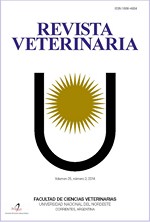Antioxidant effect of lutein protects against oxidative damage to porcine spermatozoa
DOI:
https://doi.org/10.30972/vet.3013876Palavras-chave:
Porcine, spermatozoa, reactives oxygen species, chemiluminescence, luteinResumo
Boar sperm is especially susceptible to peroxidative damage generated by reactive oxygen species (ROS). Chemiluminescence was initiated by incubating porcine semen in an in vitro ascorbate-Fe++ system, a technique that allows the evaluation of oxidative stress in these cells. Lutein is known for its antioxidant effects, chemically it is a dihydric derivative of α-carotene and belongs to the group of xanthophylls. The main objective of this study was to investigate the antioxidant effect of lutein on boar spermatozoa. The effect of lutein was analyzed by two methods: 1) by adding lutein: the sperm samples were placed in an in vitro ascorbate-Fe++ system, during 120 min at 37°C adding increasing amounts of lutein (50, 150 and 250 μg) per mg of protein and 2) by incubation with lutein in an in vitro ascorbate-Fe+2 system, for 120 min at 37°C, using spermatozoa obtained from porcine semen samples previously incubated with lutein (0.15 and 0.25 mg/ml) during 24 h at 15°C. In both methods a control group (without lutein) was used. Peroxidation was measured by chemiluminescence using a liquid scintillation counter, the light emission being quantified in cpm (counts per minute). Analyzing the effect of lutein by the two methods, it was observed that the total amount of cpm/mg of protein originated by chemiluminescence was lower in samples obtained from the lutein group than in the control group (without lutein). Total chemiluminescence (cpm total) was lower in samples obtained from the lutein group than in the control group (without lutein), with a significance of p<0.005. Percent inhibition of peroxidation was not concentration dependent. These results would demonstrate that lutein could act as an antioxidant that would protect the membranes of the sperm from oxidative damage.
Downloads
Downloads
Publicado
Como Citar
Edição
Seção
Licença
Copyright (c) 2019 M Gavazza, M Marmunti, M Compagnoni, A Palacios

Este trabalho está licenciado sob uma licença Creative Commons Attribution-NonCommercial 4.0 International License.
Política de acceso abierto
Esta revista proporciona un acceso abierto inmediato a su contenido, basado en el principio de que ofrecer al público un acceso libre a las investigaciones ayuda a un mayor intercambio global de conocimiento. La publicación por parte de terceros será autorizada por Revista Veterinaria toda vez que se la reconozca debidamente y en forma explícita como lugar de publicación del original.
Esta obra está bajo una licencia de Creative Commons Reconocimiento-NoComercial 4.0 Internacional (CC BY-NC 4.0)










.jpg)
.jpg)



